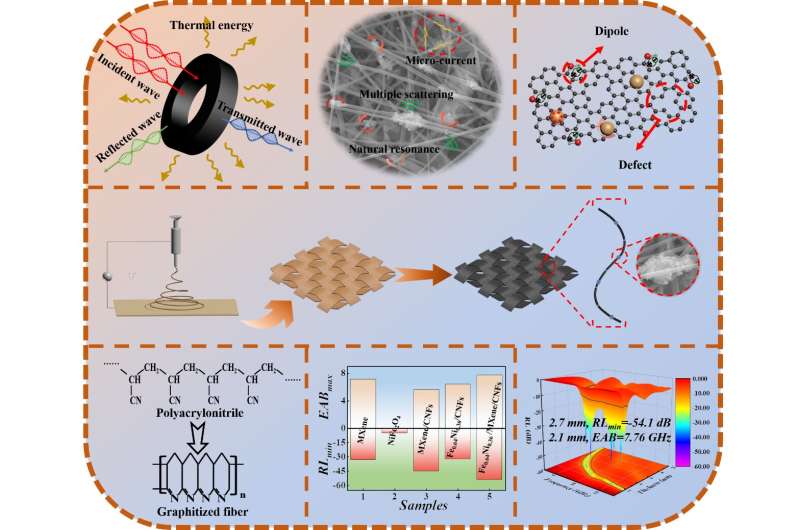A cartoon showing MXene and magnetic nanoparticles embedded in nanosheets and formed into fabric threads out of the electrospinning syringe. Credit: Nano Research, Tsinghua University Press
Engineers have employed "electrospinning," a new technique of manufacturing nanomaterials, to produce a novel fabric that offers high performance protection against electromagnetic interference, a phenomenon that can result in electronic device malfunction and at high levels of exposure can harm human health.
The technique is described in a paper published in Nano Research on December 31, 2022.
Electric and magnetic fields generated by electrical equipment can negatively interfere with digital systems either internally or externally. Such disruption can result in dangerous malfunctions if such devices are operating close to each other, particularly in the case of transportation or medical equipment such as pacemakers and insulin pumps. This interference can not only affect electronic devices, but at very high levels over short periods, it can also put at risk human biology, which in part makes use of bioelectromagnetic processes.
For all these reasons, a great deal of effort goes into shielding people, devices and parts of devices from electromagnetic interference. To avoid making devices—particularly wearable ones—overly bulky and heavy, such shielding also needs to be lightweight and flexible.
Since the 1960s, such shielding has focused on the use of metal wire fabrics, metal wire blended with chemical fibers, and silver plating. The high cost and poor flexibility, however, were major barriers to widespread acceptance of such electromagnetic protective fabrics.
More recently, and largely thanks to the electromagnetic shielding needs of military stealth technologies, novel carbon-based materials from graphene to carbon aerogels and carbon nanotubes have been applied with great success in various electromagnetic absorption and shielding applications. Thanks to the special structures of these materials, at the microscopic scale and the nanoscale, that mainly rely on scattering and reflection of radiation between layers, as well as electron transfer, to achieve high attenuation of electromagnetic waves. They also benefit from their high electrical conductivity and surface area, light weight, flexibility, and environmental sustainability.
Special mesh structure composites, constructed by combining so-called one-dimensional materials (exceptionally thin ribbons or wires between 1 and 100 nanometers in length and effectively no width) with two-dimensional materials (similarly thin materials but existing in planar form, like an extremely thin piece of paper), have particularly excellent electromagnetic wave absorption and shielding properties.
"But even here, integrating multiple functions such as electromagnetic wave protection, durability, and comfort while maintaining the inherent flexibility of fabrics has remained a formidable challenge," said Shuo Zhang, lead author of the paper and researcher with the State Key Laboratory of Biofibers and Eco-textiles, College of Materials Science and Engineering at Qingdao University.
However, in recent years a series of two-dimensional layered structures made from carbides (any compound of carbon and a metal) and nitrides (any inorganic compound of nitrogen) have begun to attract attention amongst electromagnetic shielding researchers. These 2D materials are called MXenes, as they are produced from "MAX" substances, where the M stands for an early transition metal such as titanium, vanadium and chromium; the A stands for any of the Group A elements in the periodic table such as aluminum, silicon and tin; and the X stands for carbon or nitrogen. The "ene" suffix is there to suggest a nano-structural similarity to graphene.
Typically these MXenes have been produced via a process of etching them by immersing a MAX substance in hydrofluoric acid. Their 2D layered structure offers many options for internal reflection, as well as offering superior electron transfer efficiency, high surface area, and mechanical properties, all of which deliver excellent absorption of electromagnetic waves.
The best performing MXene so far has achieved a "reflection loss" performance of -41.8 decibels at 1.1 milimeters.
The researchers thought they could outdo this by exploring methods of manufacture other than etching, and looked to electrospinning. This is a technique of manufacturing extremely narrow, nanoscale fibers. A solution containing the desired material is held in a syringe tipped with a needle and then a high-voltage power source allows electric charge to gather on the surface of the liquid. At a certain point, the electrostatic repulsion between charges exceeds the surface tension of the solution. This produces an extremely fine jet of the liquid, drying as it squirts out of the syringe, and stretching out even further by electrostatic repulsion.
Electrospinning technology also offers one of the simplest and cheapest ways to prepare nanofibers, as well as being straightforward to operate.
The microstructure, diameter, orientation and stacking density of the fibers obtained by electrospinning can also be adjusted by changing the process parameters. By adding magnetic metal elements to the electrospinning precursor solution, after the electrospinning and a high-temperature thermal treatment, the resulting nano-fibrous composite membranes produce significant magnetic loss that significantly enhances the electromagnetic wave attenuation performance.
The researchers electrospun a novel composite of two-dimensional MXene nanosheets combined with magnetic iron and nickel nanoparticles, as well as one-dimensional carbon nanofibers (CNFs). The multi-dimensional composite electromagnetic protective fabric obtained by electrospinning effectively avoids an agglomeration of 1D structures and a self-stacking of 2D structures—challenges that have bedeviled earlier MXene electromagnetic absorber material manufactured in the past—while slashing costs and eliminating the difficulty of processing.
Their material indeed beat the previous best performer, achieving an electromagnetic absorption performance of -54.1 decibels at 2.7 mm, while offering high flexibility and a lightweight waterproofing that offers a superior durability to the protective fabric in harsh environments.
More information: Shuo Zhang et al, Electrospun Fe0.64Ni0.36/MXene/CNFs nanofibrous membranes with multicomponent heterostructures as flexible electromagnetic wave absorbers, Nano Research (2022). DOI: 10.1007/s12274-022-5368-1
Journal information: Nano Research
Provided by Tsinghua University Press
























